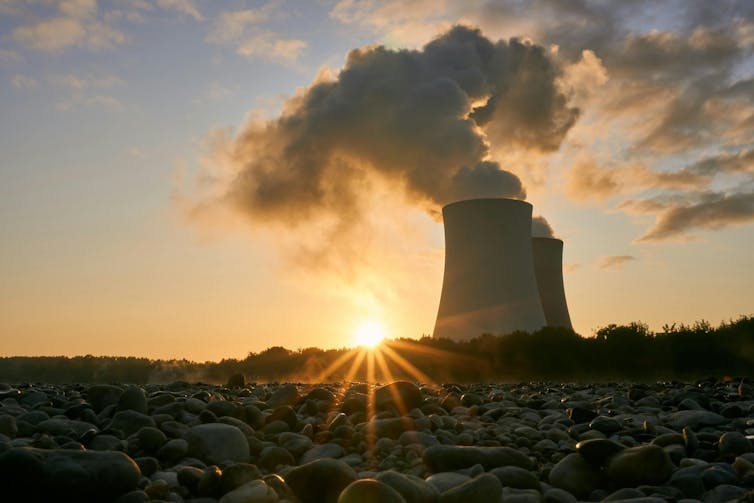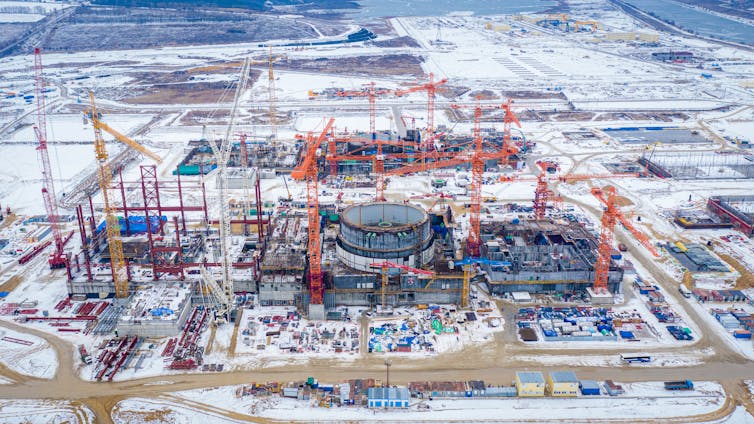Opposition Leader Peter Dutton’s plan for nuclear power in Australia has provoked a great deal of discussion and analysis — most of it critical.
Experts point out the Coalition’s long-awaited modelling involves both highly optimistic costings and a massively lower demand for electricity than expected in official projections.
In the upcoming federal election campaign, debate over the hypothetical costs and benefits of nuclear power will doubtless play a big role. But this conceals the real issue.
As in every election over the last 20 years, at stake will be the question of whether Australia chooses a clean energy future, or prolongs the life of coal and gas — an outcome the nuclear plan relies on.
In that sense, nuclear energy is shaping up as an election fig leaf like no other.

Decades until first power
Even if the Coalition’s plans go ahead, concrete will not be poured for a nuclear plant before the 2030s – three or more elections away. To see why, it’s worth examining recent international experience.
In 2006, the United Arab Emirates and other Persian Gulf states commissioned a study on the peaceful use of nuclear power. It was released in 2008 and the following year, Korean firm KHNP was selected to build four reactors.
Final approval was not granted until 2012. The reactors began commercial operation between 2020 and 2024. The UAE has made no further nuclear orders and is, instead, rapidly expanding solar power.
In 2020, Czechia began the process of replacing its ageing Soviet-era reactors. This year, it reached an agreement with KNHP, though the contract is yet to be finalised. Authorities expect the reactors to begin producing power commercially in 2038.
The Czech deal indicates nuclear is hardly cheap — each reactor will cost A$12.8 billion and produce power at $225 per megawatt hour (mWH). By contrast, CSIRO has priced firmed or “backed up” renewable energy – that is, renewables combined with transmission and storage infrastructure — at between $91 and $131 per mWH.
France has long been held up as the poster child for nuclear power, because it relies on nuclear for about 70 per cent of its power, far more than any other nation.
In 2022, President Emmanuel Macron announced a desire to go further still by building up to 14 new reactors. Construction of the first is due to start in 2027.
These examples suggest five years is a realistic minimum period from decision to construction. But Australia is highly unlikely to achieve this minimum.
Czechia and France, for example, already had well-established nuclear regulatory regimes. By contrast, Australia would need to establish and staff a nuclear power authority from scratch. Our existing organisation, ANSTO, is set up only to manage tiny research reactors.
The UAE was also starting from scratch. But the UAE is a near-absolute monarchy — so courts, environmental impact studies and public consultation did not slow the process. And plants were built by migrant workers without union representation or rights of any kind.
In Czechia and France, the reactors can be located at existing nuclear power plants. Dutton wants to build nuclear on the sites of existing coal plants to take advantage of existing transmission lines, but it’s not that simple. For instance, emergency evacuation systems are needed to deal with the small but real possibility of a catastrophic accident.
Then there is the problem of overriding the wishes of the current owners and of state governments opposed to the plan.
All this means a Dutton government would need at least two full terms in office before it would be in a position to commit the tens of billions of dollars necessary to fund the proposed publicly owned nuclear industry. Then comes years more of actual construction.

Coal and gas would fill the gap
Based on recent experience in developed countries, nuclear power is unlikely to come online before 2045, by which time our existing coal plants would be well past their expected lifespan. Many would break down. How would this energy gap be filled?
The answer is already clear. The core of Dutton’s energy policy — the part that would take effect immediately — is to keep coal plants running as long as possible, and then to switch to gas. It would also likely mean suppressing renewable energy in favour of coal and gas.
Dutton has already vowed to scrap the offshore windfarm zone planned for the Illawarra region of New South Wales, despite the fact his party passed laws paving the way for offshore wind in 2021.
Offshore wind is a missing piece of the puzzle for renewables in Australia, because winds offshore blow strongly and more consistently than on land. But the nascent sector could easily be destroyed at the stroke of a pen, using the Commonwealth’s powers over Australian waters.
Queensland’s newly elected LNP government is already showing what that might look like, spending $1.4 billion in propping up coal, while killing off plans for a major pumped-hydro facility.
Given Australia’s ageing coal-fired power stations are breaking down more often, going nuclear would mean spending billions on extending their lives while discouraging solar and wind.
This could easily produce blackouts, or the threat of blackouts in short order. Here, too, Dutton has a solution: more gas.
Only two weeks ago, Australia’s major gas producers paid for front-page stories across many Murdoch newspapers claiming gas-fired electricity would be necessary.
There is nothing new here. Under the Morrison Coalition government, a taskforce set up to deal with supply chain problems caused by the COVID pandemic produced, instead, a report advocating a gas-led recovery.
Wrong way, go back
Australia should not be distracted by nuclear power.
The Coalition plan for an Australian electricity supply, based on extended reliance on coal and gas, will rule out any chance this nation meets its commitment to reduce greenhouse gas emissions and contribute to the global climate effort.
It would also result in more expensive and less reliable electricity for Australian households and businesses.
John Quiggin, Professor, School of Economics, The University of Queensland
This article is republished from The Conversation under a Creative Commons license. Read the original article published Dec. 16, 2024.












